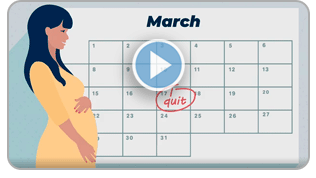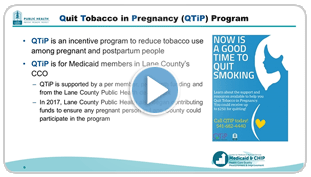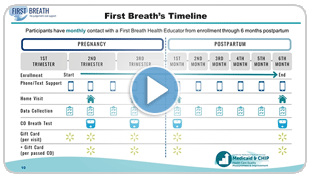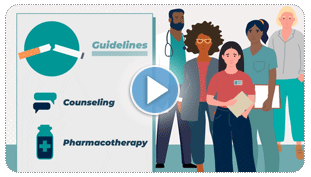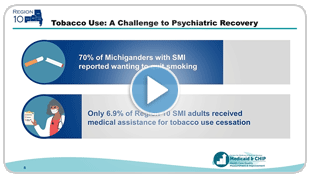Learn More:
- Quit for Two
- Tobacco Use and Pregnancy: Resources
- Tobacco Use and Quitting Among Individuals with Behavioral Health Conditions
- Tobacco Cessation in Substance Use Disorder Treatment Settings
- Behavioral Health and Tobacco Use
- Tobacco Control Efforts in Rural America
- Advancing Tobacco Prevention and Control in Rural America
As state Medicaid and Children’s Health Insurance Program (CHIP) programs expand coverage and improve access to tobacco cessation services, it is important to consider beneficiaries who have specific needs or conditions or are in certain settings. For example, adults with behavioral health conditions and people living in rural areas are more likely to use tobacco, pregnant people enrolled in Medicaid use tobacco at higher rates than pregnant people with other insurance.
For more information on these materials and other QI technical assistance, please email MedicaidCHIPQI@cms.hhs.gov.
Tobacco Cessation for Pregnant People
An estimated 20 percent of pregnant people enrolled in Medicaid smoke during pregnancy. The prevalence is even higher in certain geographic areas and groups, such as people under 24 years old. Smoking during pregnancy and the postpartum period harms pregnant people and their infants.
States are required to cover diagnostic, therapy, and counseling services, as well as pharmacotherapy for tobacco cessation for pregnant people, including during the prenatal and postpartum periods. Please see State Medicaid Director Letter #11-007.
States have used various strategies to increase tobacco cessation among pregnant people, including incentives and intensive counseling services. The tobacco cessation driver diagram and change idea table include more examples of evidence-based and evidence-informed QI interventions tailored to Medicaid and CHIP leaders.
Video | Transcript: Tobacco Use and Cessation Efforts among Pregnant Individuals Enrolled in Medicaid and CHIP
Quitting tobacco is one of the best things pregnant people can do for their own and their babies’ health. This brief video provides an overview of how smoking affects both the birthing person and child, explains why tobacco cessation is a priority for pregnant people, and describes three strategies Medicaid and CHIP agencies can use to decrease tobacco use and improve cessation services for this population.
Video | Transcript: Supporting Individuals Enrolled in Medicaid and CHIP with Tobacco Cessation Before, During, and After Pregnancy
JudyAnn Bigby, M.D., maternal and infant health expert and former secretary of health and human services for the Commonwealth of Massachusetts, provides insight into why pregnant people use tobacco and the unique challenges they face in quitting. Dr. Bigby describes successful strategies that state Medicaid and CHIP agencies can adopt to help people quit tobacco before, during, and after pregnancy.
Video | Transcript: State Story—Oregon Quit Tobacco in Pregnancy (QTiP) Program
Financial and nonmonetary incentives are often used to encourage, reinforce, and sustain behavioral change for people who smoke. This brief video provides an overview of the QTiP program in Lane County, Oregon, which helps pregnant and postpartum people enrolled in Medicaid and CHIP to quit smoking.
Video | Transcript: State Story—Wisconsin First Breath Program
This brief video discusses Wisconsin’s First Breath program and its multipronged approach to providing tobacco cessation support to pregnant and postpartum people. The program features the use of intensive counseling services, self-help materials, and incentives and gifts for participants. First Breath staff share lessons learned from the first years of the program and the program improvements made in response.
Tobacco Cessation for Adults with Behavioral Health Conditions
Adults with behavioral health conditions (such as mental health or substance use disorders) are more likely to smoke than the general population. Smoking is linked to worse symptoms and outcomes among people with behavioral health conditions, including greater depressive symptoms, a greater chance of psychiatric hospitalization, increased suicidal behavior, and relapses in drug and alcohol use. Many people with behavioral health conditions want to stop smoking but have a hard time quitting and might benefit from extra help. Options for helping this population quit smoking include counseling, behavioral therapy, and medications.
State-specific strategies used to increase tobacco cessation among adults with behavioral health conditions include enforcing smoke-free policies at behavioral health treatment centers and addressing misperceptions held by behavioral health care providers, such as the idea that abstaining from tobacco could worsen psychiatric symptoms. The tobacco cessation driver diagram and change idea table include more examples of evidence-based and evidence-informed QI interventions tailored to Medicaid and CHIP leaders.
Video | Transcript: Supporting Tobacco Cessation for Adults with Mental Health and Substance Use Disorders Enrolled in Medicaid and CHIP
This brief video provides an overview of the challenges adults with mental health and substance use disorders face when quitting smoking and describes five strategies Medicaid and CHIP agencies can use to improve tobacco cessation services for this population.
Video | Transcript: State Story—Improving Tobacco Cessation Among Adults with Serious Mental Illness in Michigan
This brief video gives an overview of Michigan’s Region 10 Prepaid Inpatient Health Plan performance improvement project, which successfully increased the use of tobacco cessation resources for adults with serious mental illness.
For more information on these materials and other QI technical assistance, please email MedicaidCHIPQI@cms.hhs.gov.


